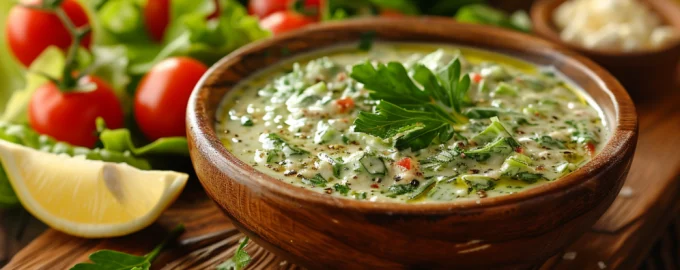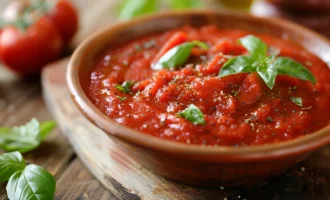Caesar dressing, the heart of the Caesar salad, is an iconic sauce with a rich history that dates back to the 1920s. Its invention is credited to Italian-American restaurateur Caesar Cardini, who concocted the dressing in his Tijuana restaurant. Legend has it that Cardini created the salad from a few ingredients he had on hand during a busy Fourth of July weekend. The original recipe was prepared tableside, adding flair to its presentation. Traditionally, Caesar dressing is served with romaine lettuce, croutons, and parmesan cheese, making up the classic Caesar salad. Over time, the dressing has found its way into wraps, as a dip, and even as a marinade.
- Olive oil 120 ml
- Egg yolks 30 g
- Fresh lemon juice 30 ml
- Anchovy fillets, finely minced or anchovy paste 10 g
- Dijon mustard 15 g
- Worcestershire sauce 5 ml
- Garlic, minced 5 g
- Freshly grated Parmesan cheese 30 g
- Salt to taste
- Freshly ground black pepper to taste
- In a bowl, whisk together the egg yolks and lemon juice until the mixture is well blended and slightly thickened. This creates the base of your emulsion.
- Incorporate the minced anchovies (or anchovy paste), Dijon mustard, Worcestershire sauce, minced garlic, salt, and pepper into the yolk mixture. Whisk until everything is thoroughly combined.
- While continuously whisking, slowly drizzle in the olive oil. This process should be gradual to ensure that the oil fully emulsifies with the egg yolk mixture, creating a thick, creamy sauce.
- Once the dressing has reached a creamy consistency, fold in the freshly grated Parmesan cheese.
- Taste the dressing and adjust the seasoning with more salt, pepper, or lemon juice, according to your preference.
Storage Tips
Caesar dressing should be stored in an airtight container in the refrigerator and is best if used within 3-5 days, considering it contains raw egg yolks. For a longer shelf life, consider using pasteurized egg yolks.
Useful Properties of the Main Ingredient
Olive oil, a key ingredient in Caesar dressing, is lauded for its health benefits. It’s rich in monounsaturated fats, which are known to be heart-healthy. Olive oil also contains antioxidants and vitamin E, which can reduce inflammation and may lower the risk of chronic diseases.
Interesting Facts
- Despite its association with Roman emperors, the Caesar salad and its dressing were named after Chef Caesar Cardini, not Julius Caesar.
- The original Caesar salad did not contain anchovies as a separate ingredient; the anchovy flavor came from the Worcestershire sauce. Over time, anchovies became a staple ingredient in the dressing for added depth of flavor.
- Caesar salad and its dressing gained popularity in the United States during the Prohibition era, partly because people traveled to Tijuana, Mexico, to drink alcohol and ended up falling in love with Cardini’s creation.
Homemade Caesar dressing is a delightful blend of savory ingredients, yielding a creamy sauce that’s both versatile and delicious. Whether drizzled over a traditional Caesar salad or used in innovative ways, this dressing brings a touch of gourmet to everyday meals.







